Warning signs of a clogged drain are not new to explain. The water either drains very slowly or there will be no signs of water drainage at all. You might experience odd odor too.
Clogged drain might look like a simple problem but it would make the water overflow and also damage floors and tiles around it. Roof drain clog can cause serious problems too. Every house in the world has this drain clogging problem.
Why Does a Drain Gets Clogged?
Certain waste products tend to go through the drain every day. If it is a bathroom drain or sink drain, hair and soap residue with other wastes would be drained. In case of kitchen sink, organic waste and food particles would be drained a lot.
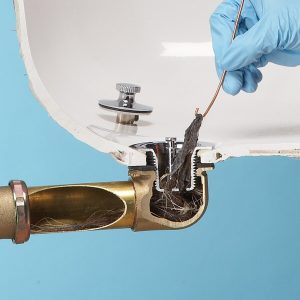 Most of the waste materials would flow along with the water and reach the sewers without any blockage to the drain. Sometimes, the hair or fat residue will pull in other wastes together and form gunk. Over time, the clog or the gunk would increase in size and end up closing the drain causing water to drain slowly or completely stagnate.
Most of the waste materials would flow along with the water and reach the sewers without any blockage to the drain. Sometimes, the hair or fat residue will pull in other wastes together and form gunk. Over time, the clog or the gunk would increase in size and end up closing the drain causing water to drain slowly or completely stagnate.
This clog has to be removed to allow water to flow through the drain. This process is called unclogging. Clog does not occur in a day or two. It is a slow process which builds up over time and thus, it becomes hard to remove within a few seconds, without proper tools and methods. This article is focused on providing simple and effective ways to unclog your drain.
Before getting to the methods, the initial step is to locate the clog. Just because your toilet sink is overflowing, it does not mean that the sink pipe is clogged. A clogged roof drain can be a reason for water stagnation in toilet sink. A clogged or stuck garbage disposal can cause water stagnation in kitchen sink and so on.
How to identify the location of the clog?
If the water drains will a loud gushing sound, first check the garbage disposal or the roof drain. If not, proceed with the methods for the clogged drain.
Top 8 Ways To Get Rid Of Clogged Drain
- Boiling Water
- Vinegar and baking soda
- Plunger
- Chemical drain cleaner
- Snake or auger or wire hanger
- Wet / dry vacuum
- Suction machine
- Professional help
Using liquid drain cleaners are also a very good option.
1. Boiling Water to Get Rid Of Clogged Drain
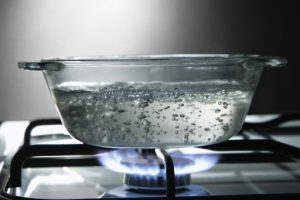 For fat residue and soap residue, boiling water would be a very effective agent for unclogging. This should be tour very first attempt. Just add a liter of hot boiling water into the clogged drain. The boiling water would dissolve sediment minerals, fats or others and makes the water drain faster.
For fat residue and soap residue, boiling water would be a very effective agent for unclogging. This should be tour very first attempt. Just add a liter of hot boiling water into the clogged drain. The boiling water would dissolve sediment minerals, fats or others and makes the water drain faster.
Add any type of salt along with boiling water and then pour it down the drain for better results. This solution would act as an abrasive solution and removes grease from the pipe. When grease is removed, there will be nothing to hold the clog together and it will break or flow along with the water.
Another method of using boiling water is to mix it with liquid dish washing soap. This will help to remove fat residue. The process is same as stated before. Boil water in a kettle and add half a cup of dish washing liquid. Immediately pour this liquid into the clogged drain.
Wait for a few minutes and flush the drain with more hot water as needed. You can repeat this as many times as required. You can also use these methods after any method which involves pressure or any solution. This boiling water will flush down any part of the clog that did not meet the equipment. This is a very good preventive measure as the water does not damage the pipe and can be used as many times, as needed.
2. Vinegar and Baking Soda to Get Rid of Clogged Drain
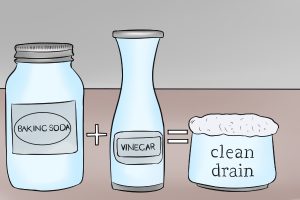 When it comes to unclogging the drain, the first method presented by anyone is a combination of cooking vinegar and baking soda. You can also use baking powder but, soda would be a better choice. Vinegar is a mild acid that is very commonly found in all kitchens.
When it comes to unclogging the drain, the first method presented by anyone is a combination of cooking vinegar and baking soda. You can also use baking powder but, soda would be a better choice. Vinegar is a mild acid that is very commonly found in all kitchens.
The brand or the type of vinegar really does not matter. Baking soda is also a similar common ingredient that is found in the shelves. When you add vinegar and baking soda, you would initiate neutralization reaction. This reaction releases a lot of carbon dioxide along with a salt. This salt would help in dissolving certain organic elements in the clog.
Add half a cup of baking soda into the clogged drain after removing any standing water. Now, add a cup of vinegar in the drain and cover the drain hole with a wet cloth for a few minutes.
During this time, boil a liter of water. Remove the wet cloth and pour the hot water through the drain. The water would drain faster showing that the clog has been removed.
You can repeat this process as many times as you wish. If needed, you can add more amount of baking soda and equivalent amount of vinegar as per your requirement. There is no hard and fast rule in the amount.
You should have enough vinegar to react with all the powder that you pour down the clogged drain. Since the method does not cause any wear and tear to the pipes, you can use it as a preventive measure too.
3. Remove the Clog With a Plunger
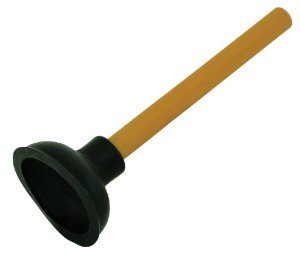 You should be very familiar with what a plunger is. For a plunger to work, there should be a minimal amount of standing water. The water should completely immerse the rubber part of the plunger, when it is made to stand upright. You can use petroleum jelly to make a perfect vacuum seal. It is optional.
You should be very familiar with what a plunger is. For a plunger to work, there should be a minimal amount of standing water. The water should completely immerse the rubber part of the plunger, when it is made to stand upright. You can use petroleum jelly to make a perfect vacuum seal. It is optional.
Now, rigorously push and pull the handle creating a change in pressure inside the pipe. You would notice that the standing water would be draining at a high speed. Sometimes, the water inside the pipe would rise up and then gets drained along with the standing water. If you find any clog with the water, remove it and dispose it in the garbage. Do not flush it into the drain again.
Though plunger is pressure based equipment, it would not cause any considerable damage to the pipelines. Thus, it can be used as many times, as needed. It is also a good preventive measure. Using vinegar and baking soda solution before plunging would quicken the time taken by the plunger to remove the clog.
4. Chemical Drain Cleaners can Unclog a Clogged Drain
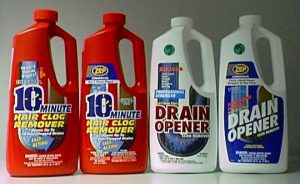 There are several types of chemical drain cleaners which are sold under different names and brands for clogged drain. Though they all look different, the main element in all the chemical drain cleaners is the same.
There are several types of chemical drain cleaners which are sold under different names and brands for clogged drain. Though they all look different, the main element in all the chemical drain cleaners is the same.
The chemical drain cleaner reacts with the clog and dissolve organic wastes and soap resides. It also dissolves the minerals deposited on the sides and fat residue. Within a few minutes, the drain would be completely unclogged.
Here are a few tips to know before you use any chemical drain cleaner.
- Do not mix any two different chemical drain cleaners at the same time. This includes using another drain cleaner within a few hours from using another. The chemical tends to stay in the clogged drain for a considerable amount of time and it would react with the other chemicals and causes unwanted and harmful fumes or damage your pipes.
- Do not use vinegar with baking soda along with any chemical drain cleaner. The chemical will react together and result in harmful side products.
- If you use a plunger after using a chemical drain cleaner, the plunger may pull out the clog along with the residue chemicals, which would lead to a chemical splash all around your room and also on you.
- If you want to use any method after using chemical drain opener, use a drain snake or plumber’s auger.
- The chemical drain opener would take a heavy toll on your pipes. Do not use any branded chemical, unless it is very essential.
- It is better to use the chemical drain opener overnight, so that you can be sure that the chemicals have drained from the pipes.
- Use cold water or lukewarm water to flush down the chemical drain cleaners. Never using hot or warm water for the same.
Other top chemicals to use as drain cleaners or unclogging are sulfuric acid and caustic soda. Dissolve caustic soda in water. You need not use hot water as the soda would eventually increases the temperature of the liquid. If you have powdered caustic soda, add it directly to the pipe.
After a few minutes, flush it down with water. If there are any plastic or metal objects in the clogged drain, you would need stronger agent like concentrated sulfuric acid. This acid can burn your skin in an instant. Thus, leave this chemical to experts.
5. Snake or Wire Hanger Good For Clogged Drain
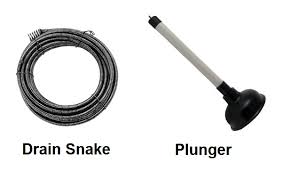
A drain snake is basically a long slender wire with a spiral, hooks or barbs at the end. The clog would get stuck in the hooks and you need to pull it out.
You need to remove the strainer or stopper in the drain. You should be able to see the drain hole for this method. Insert the hook side of the tool and slowly reel the wire into the clogged drain pipe.
When you feel a resistance, stop reeling the wire. This is the place of the clog. Now, slowly rotate the wire in one direction. This will make the clog get accumulated in the hooks. Now, pull it out slowly without stopping the rotational movement. Pull out the clog and dispose it off in the garbage.
You can also use a wire hanger and make it into a wire with a hook. Or you can use any thick wire with a hooked end. Be Careful! If you insert a lot of pressure, you can damage the pipe.
Thus, you need to be very patient. If you end up pushing the clog deep into the pipe towards the sewer line, you would need to call an expert or rent any professional equipment for the process which would cost more. Since the chances of damaging the pipes are high, this cannot be used as a preventive measure.
In case of roof drain, the wire is replaced with a long broom that is used to push the clog out through the outlet spout. If the wire breaks inside the pipe or if the wire is stuck in the pipeline, you need to call an expert. This method works only if the clog is close to the drain hole.
There are plumbing augers available in the market. It is better to leave power augers with professionals. It can be used to remove clog that are a little far away from the drain hole but, the chance of damaging the pipes is very high. Even with a small crank to the handle, you can break the pipes.
6. Remove the Drain Clog With a Wet / Dry Vacuum
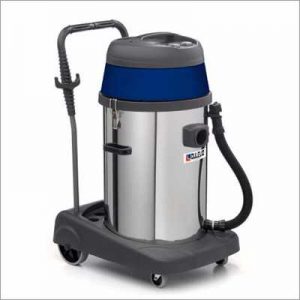 Depending on the type of the clog, you need to use a wet vacuum machine.
Depending on the type of the clog, you need to use a wet vacuum machine.
The hose should be smaller than your drain hole. There should be enough space for the hose to move around. The friction and the pressure would cause serious wear and tear.
Now, try to insert the hose and take it out to get the knack of handling the hose. Insert the hose slowly. If you feel resistance, switch on the machine. You would hear a growing sound as the motor helps the machine to suck the clog. Once you hear a hollow sound, stop the machine.
This indicates that the machine has successfully removed the clog. Now, slowly remove the hose from the drain pipe. Use any other method to remove any remaining clog in the pipeline.
You can see a selection of wet / dry vacuums for unclogging drains here. Or you can rent a wet vacuum cleaner from any rental hardware store near you. Read the manual and get tips from the seller before using it.
7. Suction Machine is Also Effective Way to Get Rid of Clogged Drain
This is an upgraded version of a normal wet vacuum cleaner. You need to be really experienced to use such a machine. The working mechanism of this machine is also very similar to that of a vacuum machine. Before you use this machine, here are a few tips which will help you.
- Wear tights clothing and remove all loose accessories. You should also move any small objects that are present near you like keys, nuts or bolts, mobile and others. The machine would suck anything that comes in its way.
- The hose comes in different size. Measure the diameter of the clogged drain hole in your house and get help from the renter to choose the right hose size for the drain. Using a larger hose would lead to wear and tear and it would even cause serious damage to the pipe.
- Learn to use the foot switch. You can also work the hose in and out of the drain pipe to get a knack of it. You should be able to use the machine with ease and comfort.
- Have a helper and ask him to stand near the power cable. When things go out of hand, ask him to switch off the power to the machine.
- When you feel a resistance, do not push it in. Switch off the suction if the clog is not removed within a few seconds. Let it cool down. Repeat the process.
- It is clearly not a preventive measure as the chances of damage and the cost of the machine are high.
- It is better to leave this method to professionals.
8. Professional Help to Unclog a Drain
There are numerous service providers and plumbers who are experts in unclogging any type of drain. Why do you need professional help when there are these many methods to follow? First of all, clog might not be the only reason to a slow or blocked drain.
Any crack or damage to the pipes would cause a decrease in the pressure. The pressure inside the pipe is very essential for the water to flow towards the sewer line. When this pressure is low due to damage, the water would stagnate even if there is no clog.
Thus, if you end up damaging the pipe while removing the clog, you may find water stagnation even though the method was successful. Thus, leave complex methods to professionals. Moreover, they can identify cracks and damages in the pipes.
In some cases, improper installation of pipes can also be a reason. Thus, get professional advice when a few methods don’t work. Using sulfuric acid, heavy suction machine or unclogging roof drains can be unsafe. You should not end up hurting you or your family members. Thus, it is better to call professionals, if you think you are about to take risk.
Conclusion
You are welcome to try each and every method one after another. A method may work on certain types of sinks or clogs. It is up to you to choose the best method.
A good preventive measure would be to avoid draining unwanted food items and hairs through the drain. If not, use any of the preventive measures mentioned in the article once in a while to reduce clog build up.